The Xiaomi Mi Note Pro and Mi Note Review
by Joshua Ho on September 11, 2015 9:00 AM ESTSystem Performance
Performance may be a rather nebulous thing - there are a number of factors that affect the performance of a smartphone in everyday tasks. One of the single most important components to overall performance is the SoC (System on a Chip). This one package will usually contain the CPU, GPU, DRAM interface, a number of fixed-function blocks, various DSPs, and other processing engines. Usually, DRAM itself is also mounted on top of the SoC package in a package on package (PoP) configuration. In order to test this and more in a smartphone, we rely on a set of benchmarks that are accepted within the industry that can reasonably represent smartphone performance. Of course, the state of the art in benchmarking is always changing, but we can say with reasonable confidence that if a smartphone or tablet performs well in our benchmarks that the SoC will be a good foundation for a smooth experience. Of course, if an OEM then decides to run unoptimized Android UIs on top of this SoC then any performance advantage could be wasted. In the case of the Mi Note, we’re looking at a relatively standard Snapdragon 801 with 3GB of LPDDR3, while the Mi Note Pro uses a more powerful Snapdragon 810 with 4GB of LPDDR4.


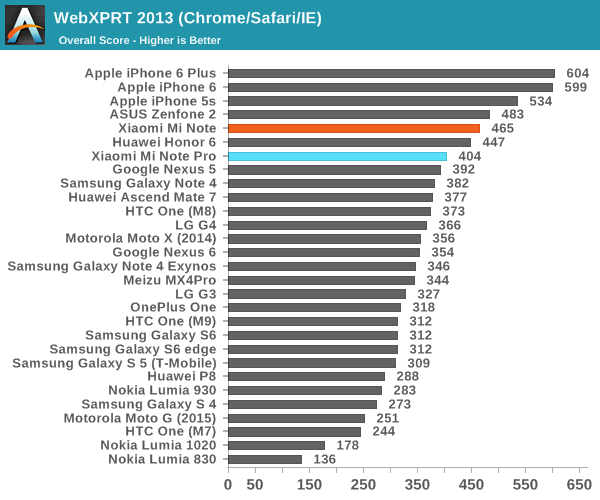
It's interesting to look at these results as we can basically see the differences that result from browser optimizations. It's also important to note here that the Xiaomi Mi Note was run with the Performance mode turned on as otherwise the CPU governor would be far too conservative for good performance. Unfortunately though, it looks like the Performance mode (as opposed to Balanced) is extremely aggressive, setting all cores online and to only use the 2.5 GHz state. Xiaomi needs to provide a more appropriate performance governor for everyday use. It's worth noting here that all benchmarks can be run without the performance governor, but the software will offer to turn it on if it detects a benchmark.
Fortunately, it seems the Mi Note Pro doesn't have these sorts of strange governor settings and performance is in line for what we'd expect from a Snapdragon 810.
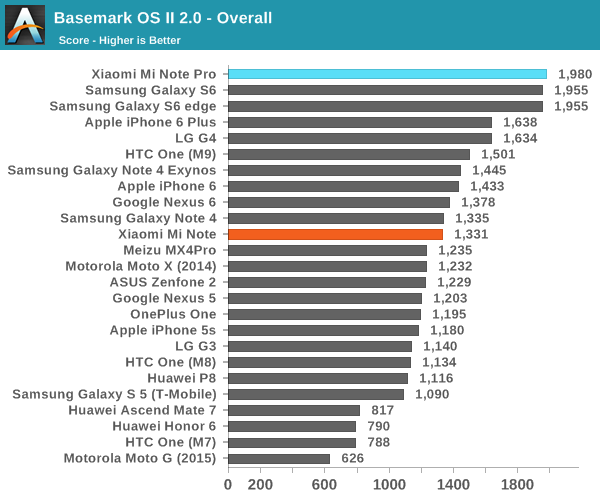
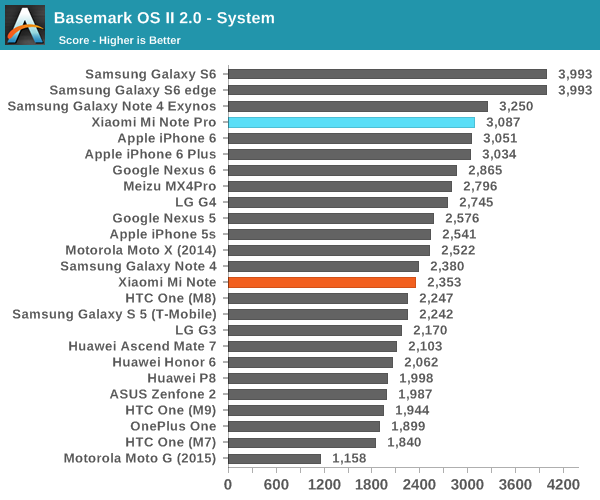

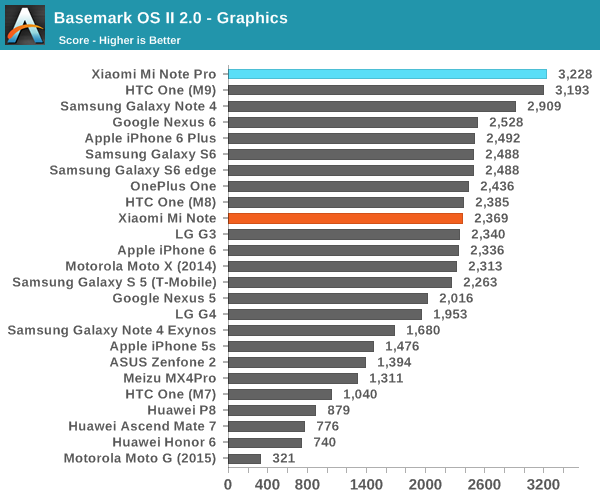
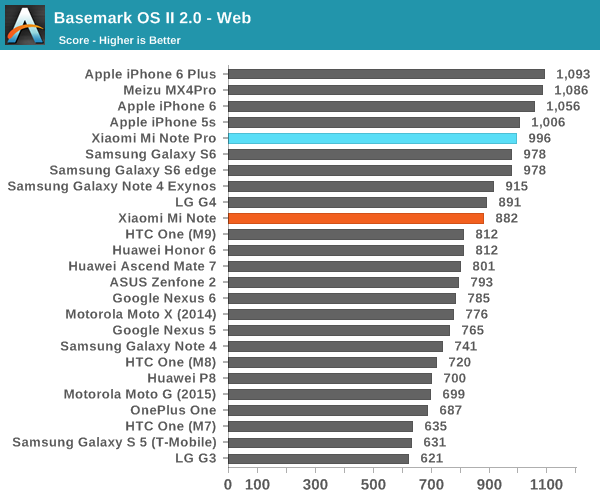
In Basemark OS II we see that performance is roughly estimated to be equal to the Galaxy S6. It seems that most of this is coming from the NAND benchmark aspect and browser optimizations as in the System subtest the Mi Note is around the same level as the Exynos 5433. The graphics subtest shows performance is identical to the One M9, which suggests that the 30 MHz bump in clock isn't going to be particularly helpful.
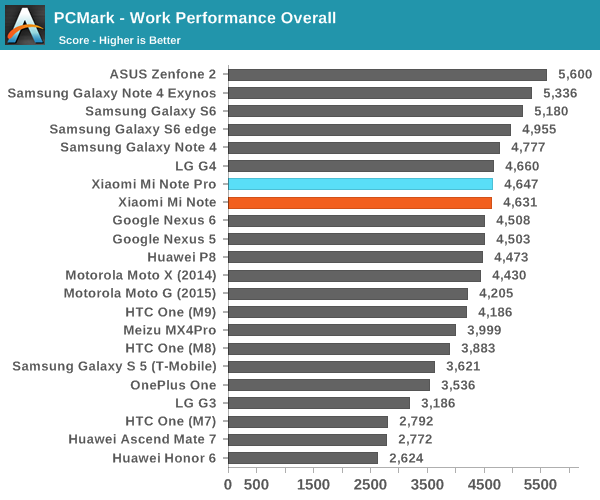
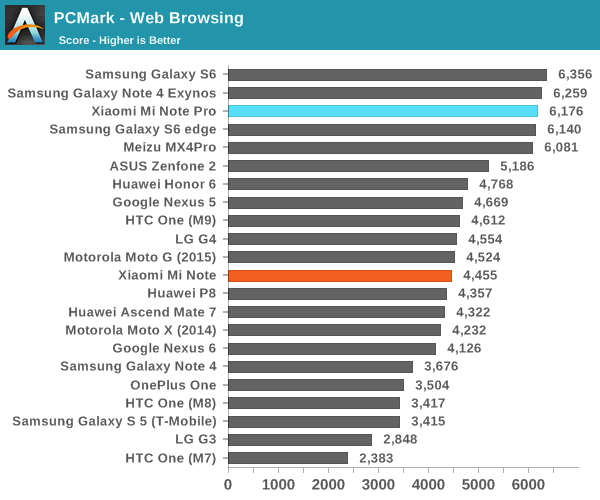
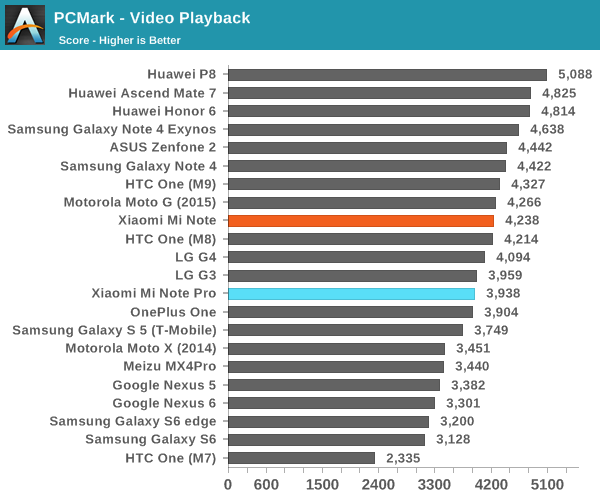
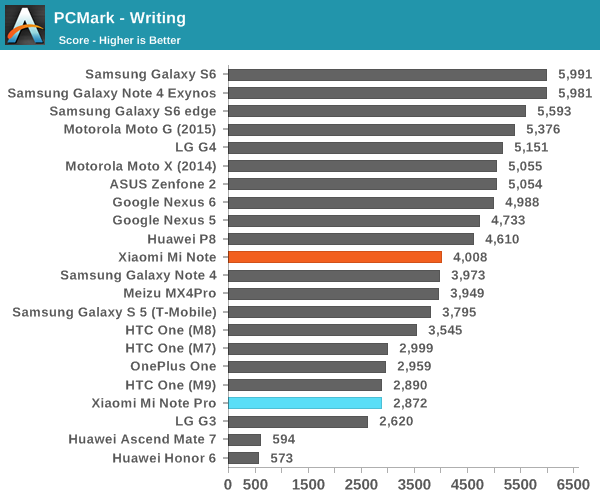
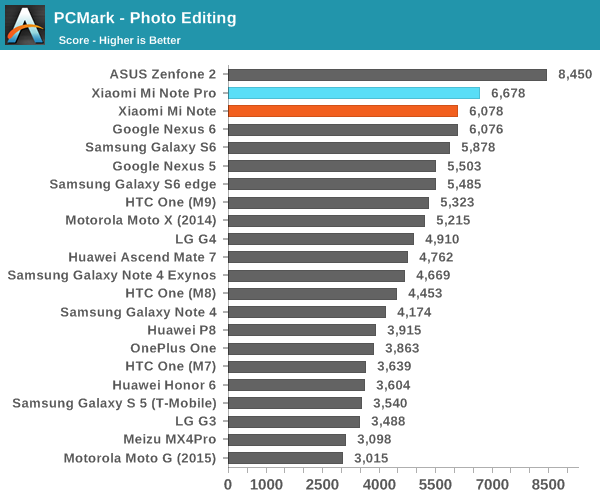
At this point it's pretty fair to say that the Snapdragon 801 is a known quantity when it comes to performance, but when it comes to the Snapdragon 810 it's still in some level of flux. For the Mi Note at least, this is mostly interesting at an academic level as a pure 2.5 GHz 4x Krait comparison relative to the Snapdragon 810. Overall, it looks like the Mi Note Pro is about the same performance as the G4, which makes sense because the governor usually only allows two A57s to stay online in all but the most extreme loads. However, performance has a wide relative variation in cases where the OEM has either invested a lot of time in optimizing their build of Android or not as much. It looks like web browsing is a major point of optimization for the Mi Note Pro as it is competitive with the Galaxy S6 in that test, but in areas like the writing subtest Xiaomi is falling behind somewhat. I suspect this is mostly a software optimization problem as PCMark is extremely sensitive to changes in Android version as seen in the Note 4 and Note 4 Exynos which are surpassing the Mi Note due to an OTA update to Lollipop despite the Mi Note's use of a performance governor.
Overall, performance of Snapdragon 810 in these mostly CPU-bound tasks is acceptable. We can still see some performance gains over Snapdragon 801 and 805 but relative to the Exynos 7420 competition things aren't quite as rosy. Of course, we can talk about software optimization but in Basemark OS II the Mi Note only squeaks by due to a high NAND performance score rather than a strong showing in any SoC performance test. In PCMark we see a similar story of some tests where the Mi Note Pro is doing well, but others where it falls short to give an average score overall. Whatever the case, it's clear that the Mi Note Pro does have a good amount of performance on tap. The Mi Note is also clearly capable of being a strong performer as seen in the performance mode benchmarks, but the balanced governor mode needs to be much better to exploit that performance. Both phones should have enough CPU performance to do pretty much any everyday task.










94 Comments
View All Comments
valinor89 - Friday, September 11, 2015 - link
Xiamomi is about to start trials with some products in the Us and other countries. You could end up having acces to this phone or its successor before long...Or do like the people who bought those korean screens early on and import.
I live in Europe and most of the products reviewed here are not directly avaiable to me, even less at the same relative price, 1€=1$ over here, but I still like to read about new product tendencies, at the minimun it lets me evaluate the products I can get in another light.
menting - Friday, September 11, 2015 - link
How are phones any ground breaking nowadays? There have been 0 phones in the past few years that are groundbreaking, with maybe the exception of the S6 Edge with the curved screen. And if it's fair to whine about something you can't use, then 1) Verizon/Sprint customers will be whining more than 50% of the time here, and 2) Who said you can't use it? Does the lack of LTE make it unusable? BS.Yaru - Sunday, October 4, 2015 - link
You don't have to care but I very very much do. Not all of their products are only applicable to the US, some of them apply to other countries as well.Also, you can buy a Xiaomi phone from the US. Much like I can buy US phones from here. The iPhone 6+ I'm using to type this comes directly from the US (a T-Mobile to be exact). Just because Xiaomi doesn't sell it directly doesn't mean you can't buy it.
lilmoe - Friday, September 11, 2015 - link
That's the worst thing one could ever do really. You should buy a product that has proper support in your country. Good luck finding parts or repairing the device. And good luck if you get a lemon.mforce - Friday, September 11, 2015 - link
Actually I bought an LG Optimus G made for Korea ( F180L ) which I've flashed with the ROM for E975 but keeping the modem part of the F180L .... I have all the 2G and 3G bands working perfectly here in the EU and the phone has been doign well for 2 years now.It is true that it's a risk you're going to make when buying without a local warranty but the seller might still honor your warranty if you send it back. Also yes you need to carefull look at the supported bands but some might just work out fine and be what you need in your country too.
Xiaomi does make phones which have all the right bands for the EU ( including LTE ) so I'm OK with reading reviews about Xiaomi phones such as this.... this isn't a US only website you know. Maybe folks from China read it too for instance ... Also many Xiaomi phones are available in India where they speak EN so ...
DigitalFreak - Friday, September 11, 2015 - link
You just don't get it. No-one said they shouldn't review non-US phones. Just put a blurb in the beginning saying it doesn't support US bands. Why is that one simple thing so hard for people to comprehend?Pissedoffyouth - Friday, September 11, 2015 - link
>I'd rather not waste my time reading a review of something that's only available in Asia/Europe.Why not? I'm a tech head, I'm happy to read reviews of droids only available on Verizon even though I'm in Europe because its great to see what competition ithere is.
menting - Friday, September 11, 2015 - link
talk about being self-centered! So they'll have to say if it's going to be on Sprint and/or Verizon too I suppose?DigitalFreak - Friday, September 11, 2015 - link
Yeah, because I'm the only person who reads through a review only to find out they won't be able to use the device.BMNify - Friday, September 11, 2015 - link
Anandtech is an International website with only 40% of the readership coming from USA and Xiaomi already caters to the largest smartphones markets that is China, India, Brazil, Taiwan, Singapore, Malaysia and Philippines. So, your redneck 'Murican pride is misplaced here.